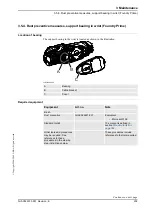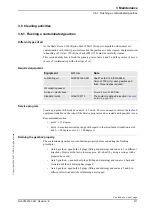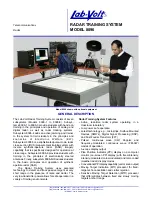
4 Repair
4.2.3. Mounting instructions for seals
219
3HAC022033-001 Revision: E
©
Co
py
rig
h
t 200
4 - 20
08 ABB.
All r
ig
h
ts r
e
se
rv
ed
.
4.2.3. Mounting instructions for seals
General
This sections details how to mount different types of seals to the robot.
Equipment
Rotating seals
The procedure below details how to fit rotating seals.
CAUTION!
Please observe the following before commencing any assembly of seals:
•
Protect the sealing surfaces during transport and mounting.
•
Keep the seal in its original wrappings or protect it well before actual mounting.
•
The fitting of seals and gears must be carried out on clean workbenches.
•
Use a protective sleeve for the sealing lip during mounting, when sliding over threads,
keyways, etc.
Flange seals and static seals
The procedure below details how to fit flange seals and static seals.
Equipment, etc.
Art. no.
Note
Grease
3HAB3537-1
Used to lubricate the seals.
Action
Note
1. Check the seal to ensure that:
•
the seal is of the correct type (provided with cutting
edge).
•
there is no damage to the sealing edge (feel with a
fingernail).
2. Inspect the sealing surface before mounting. If scratches or
damage are found, the seal must be replaced, as it may
result in future leakage.
3. Lubricate the seal with
grease
just before fitting. (Not too
early as there is a risk of dirt and foreign particles adhering
to the seal.)
Fill the space between the dust tongue and sealing lip to 2/
3 with grease. The rubber coated external diameter must
also be greased, unless otherwise specified.
Art. no. is specified in
.
4. Mount the seal correctly with a mounting tool.
Never hammer directly on the seal as this may result in
leakage.
Action
1. Check the flange surfaces. They must be even and free from pores.
It is easy to check flatness using a gauge on the fastened joint (without sealing
compound).
If the flange surfaces are defective, the parts may not be used because leakage could
occur.
Continues on next page
















































